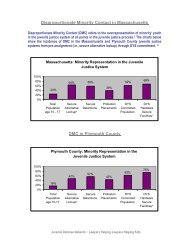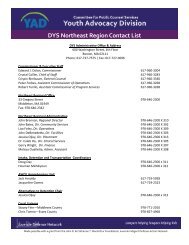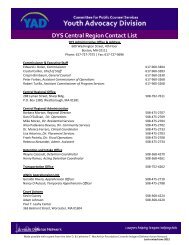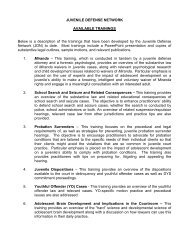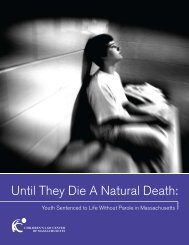States rethink 'adult time for adult crime' - the Youth Advocacy Division
States rethink 'adult time for adult crime' - the Youth Advocacy Division
States rethink 'adult time for adult crime' - the Youth Advocacy Division
You also want an ePaper? Increase the reach of your titles
YUMPU automatically turns print PDFs into web optimized ePapers that Google loves.
mind-reading device will threaten our privacy and mental freedom, leading some<br />
to call <strong>for</strong> <strong>the</strong> legal system to respond with a new concept of “cognitive liberty.”<br />
One of <strong>the</strong> most enthusiastic proponents of neurolaw is Owen Jones, a professor<br />
of law and biology at Vanderbilt. Jones (who happens to have been one of my<br />
law-school classmates) has joined a group of prominent neuroscientists and law<br />
professors who have applied <strong>for</strong> a large MacArthur Foundation grant; <strong>the</strong>y hope<br />
to study a wide range of neurolaw questions, like: Do sexual offenders and violent<br />
teenagers show unusual patterns of brain activity Is it possible to capture brain<br />
images of chronic neck pain when someone claims to have suffered whiplash In<br />
<strong>the</strong> mean<strong>time</strong>, Jones is turning Vanderbilt into a kind of Los Alamos <strong>for</strong><br />
neurolaw. The university has just opened a $27 million neuroimaging center and<br />
has poached leading neuroscientists from around <strong>the</strong> world; soon, Jones hopes to<br />
enroll students in <strong>the</strong> nation’s first program in law and neuroscience. “It’s<br />
breathlessly exciting,” he says. “This is <strong>the</strong> new frontier in law and science —<br />
we’re peering into <strong>the</strong> black box to see how <strong>the</strong> brain is actually working, that<br />
hidden place in <strong>the</strong> dark quiet, where we have our private thoughts and private<br />
reactions — and <strong>the</strong> law will inevitably have to decide how to deal with this new<br />
technology.”<br />
II. A Visit to Vanderbilt Owen Jones is a disciplined and quietly intense man, and<br />
his enthusiasm <strong>for</strong> <strong>the</strong> trans<strong>for</strong>mative power of neuroscience is infectious. With<br />
René Marois, a neuroscientist in <strong>the</strong> psychology department, Jones has begun a<br />
study of how <strong>the</strong> human brain reacts when asked to impose various punishments.<br />
In<strong>for</strong>mally, <strong>the</strong>y call <strong>the</strong> experiment Harm and Punishment — and <strong>the</strong>y offered to<br />
make me one of <strong>the</strong>ir first subjects.<br />
We met in Jones’s pristine office, which is decorated with a human skull and<br />
calipers, like those that phrenologists once used to measure <strong>the</strong> human head; his<br />
fa<strong>the</strong>r is a dentist, and his grandfa<strong>the</strong>r was an electrical engineer who collected<br />
tools. We walked over to Vanderbilt’s Institute of Imaging Science, which,<br />
although still surrounded by scaffolding, was as impressive as Jones had<br />
promised. The basement contains one of <strong>the</strong> few 7-tesla magnetic-resonanceimaging<br />
scanners in <strong>the</strong> world. For Harm and Punishment, Jones and Marois use<br />
a less powerful 3 tesla, which is <strong>the</strong> typical research M.R.I.





